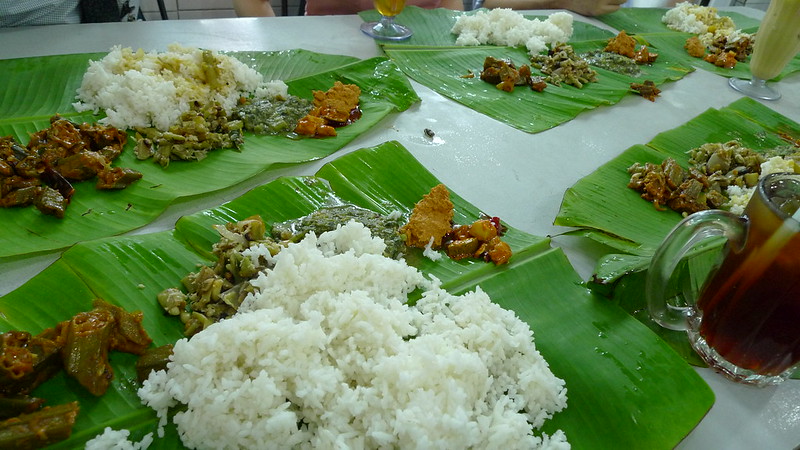By Sudha Balagopal

On festival days in India, my grandfather purchased banana leaves. He trimmed the broad-long leaves―some a bold, dark green, others a shy, lighter shade―into sixteen-inch lengths, rinsed them to remove dirt, then wiped each plasticky leaf with an old dish towel. Grandfather taught me that each banana cluster is called a hand; every hand has several fingers of fruit. At school we learned about the generous banana tree that gives us edible fruit, flowers, and stems, but the teachers omitted any mention of using the leaves as plates.
Seven stainless steel plates gleamed from my grandparents’ dish drainer above the kitchen sink. I asked my grandfather if we needed the banana leaves because they didn’t have enough plates for everyone. His eyes gleamed and he chuckled.
My grandparents ate with their fingers. They raised their children to do so as well. At my convent-run school with a focus on westernized education, the nuns subtly instilled in me the superiority of utensils―forks, knives, spoons. The sheer sensory relish of eating with the fingers―an amalgam of touch, taste, smell and sight―eventually got folded, tucked, and locked into a negative space in my brain.
Grandmother raised five children in a modest, big-city apartment, cooking without today’s common basics―not even a blender or a refrigerator. Yet she created mouth-watering chutneys and togayals on the ammi, a grinding stone embedded on her kitchen counter. She pounded fragrant spices with the itikkal, the mortar and pestle, and churned super-soft butter from home-set yogurt using her mattu. She cooked rice on the stove, and used a fine-mesh muslin cloth to drain the excess starchy water.
After grandfather readied the leaves, we sat cross-legged on the floor, in a row. Lunch was served to us in the traditional order of items with food placed on either side of each banana leaf’s horizontal divide―curries on the top half, rice on the bottom half. We had four or five varieties of vegetables, a chutney, and of course, the soupy-spicy sambar and rasam, not to mention grandmother’s homemade lemon pickle, plus fried vadas, sometimes even homemade potato chips, and rich-sweet payasam to round off the spread.
I spent the occasion preoccupied with keeping my palm high above the food―as if the meal would sully my hand. Grandmother had been laboring from dawn to prepare the feast; I didn’t spare a thought for the hours of work involved, nor did I compliment her. Instead, I focused on working with the tips of my unskilled fingers, longing for a plate, a spoon, while others ate with audible gusto. I muttered and grumbled as I chased after the food, trying to contain the delicacies within my leaf’s boundaries. After I washed my hands, I smelled my fingers. The aroma of coriander and curry leaves lingered.
Three decades later in America, a friend gifts us an Ecuadorian banana sapling for our home. The plant grows slender and tall, and soon sports a thick stem and a plethora of broad leaves. The tree sprouts banana flowers, and eventually, bunches of small fruit.
Two days before the Pongal festival, my husband cuts the leaves from our tree. They sit, stacked like hints, on our patio chairs. I cannot bring them in; I don’t have the heart to toss them in the trash either.
“It’s harvest celebration in India in a couple of days,” my husband tells our American-born children.
On Pongal day, I retrieve the banana leaves from the patio. I snip tips and edges, rinse the foliage in warm water before drying them with a paper towel.
“You’re cleaning banana leaves?” my younger daughter asks.
“Yes. To eat off of instead of plates, like we did at my grandmother’s.”
“That’s so…” I gird myself for protest words like “old-fashioned” or “inconvenient.” Instead, she says, “eco-friendly.”
I didn’t know the word at her age.
Half a world away from where I grew up, I am serving pongal―a rice and mung dal dish cooked with cumin and whole black pepper―on our Ecuadorian banana leaves. I pair the rice with coconut chutney. For dessert, there’s chakra pongal, the sweet version, rich gold from brown sugar, slick with melted ghee, roasted nuts peeping from here and there.
I rummage through the kitchen drawer.
“Spoon or a fork?” I call out.
“What? And tear through the leaf?” My older daughter asks.
She digs into the food, licks her fingers.
Sudha Balagopal‘s work appears in Fractured Lit, Monkeybicycle and Smokelong Quarterly, among other journals. Her novella-in-flash, Things I Can’t Tell Amma, was published by Ad Hoc fiction this year. She has been nominated for the Pushcart Prize and Best Small Fictions, and has a micro story in Best Microfiction 2021. She is also listed in the Wigleaf Top 50. More at www.sudhabalagopal.com.
Photo: Shreyak Singh on Unsplash